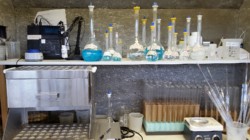 Testing
Testing
The Environmental Protection Agency publishes laboratory analytical methods that are used by municipalities to analyze the chemical, physical and biological components of wastewater and other environmental samples that are required by regulations under the authority of the Clean Water Act (CWA). Most of these methods are published as regulations in the Code of Federal Regulations (CFR) at Title 40 Part 136.
The Fond du Lac Regional Wastewater Treatment & Resource Recovery Facility (WTRRF) has a Wisconsin DNR Certified laboratory which analyzes wastewater and solids samples using state-of-the-art equipment. Additionally, the laboratory analyzes samples from local industries for permitting and billing purposes as well as commercial clients.
The operation of complex plant processes requires monitoring and testing on a continuous basis. The plant laboratory is used for testing the quality of the water as it passes through each plant process and the sludge quality as is passes through the solids handling process. Laboratory data is also used to assure compliance with stringent regulatory requirements for discharge of the treated water and recycling of biosolids.
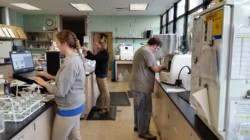
Our on-site instrumentation provides information and records data on wastewater quality around the clock. Information is collected and stored automatically in a database for evaluation by our operators and other staff members.The data which is generated from this testing is used to monitor the effectiveness of the treatment plant, ensure compliance with the WiDNR Wisconsin Pollutant Discharge Elimination System (WPDES) permit, and evaluate the health of Lake Winnebago.
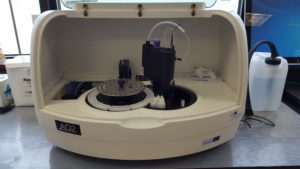 Samples are collected and analyzed by certified laboratory analysts in the on-site State certified laboratory. This information is also added automatically to our operational database.Public wastewater systems must demonstrate that their water meets health based standards by periodically monitoring for the presence of specific contaminants. Approved analytical methods must be used when analyzing water samples to meet federal monitoring requirements or to demonstrate compliance. EPA reviews and approves methods that can be used.
Samples are collected and analyzed by certified laboratory analysts in the on-site State certified laboratory. This information is also added automatically to our operational database.Public wastewater systems must demonstrate that their water meets health based standards by periodically monitoring for the presence of specific contaminants. Approved analytical methods must be used when analyzing water samples to meet federal monitoring requirements or to demonstrate compliance. EPA reviews and approves methods that can be used.
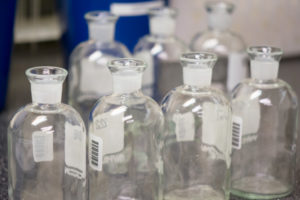 Per permit requirements, the facility monitors daily Biochemical Oxygen Demand (BOD) of a variety of samples. BOD measures the amount of oxygen required by aerobic microorganisms to decompose the organic matter in a sample of water, such as that polluted by sewage. It is the measure of how much oxygen in the water will be required to finish digesting the organic material left in the sample. Therefore, a low BOD is an indicator of good quality water, while a high BOD indicates polluted water.
Per permit requirements, the facility monitors daily Biochemical Oxygen Demand (BOD) of a variety of samples. BOD measures the amount of oxygen required by aerobic microorganisms to decompose the organic matter in a sample of water, such as that polluted by sewage. It is the measure of how much oxygen in the water will be required to finish digesting the organic material left in the sample. Therefore, a low BOD is an indicator of good quality water, while a high BOD indicates polluted water.
During the BOD incubation period, dissolved oxygen (DO) is consumed by bacteria when large amounts of organic matter from sewage or other discharges are present in the water. DO is the actual amount of oxygen available in dissolved form in the water. When the DO drops below a certain level, the life forms in that water are unable to continue at a normal rate. The decrease in the oxygen supply in the water has a negative effect on the fish and other aquatic life. Fish kills and an invasion and growth of certain types of weeds can cause dramatic changes in a stream or other body of water.
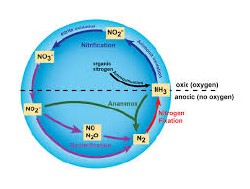 Permitting requires the analysis of Ammonia as Nitrogen on a daily basis. Nitrogen is an essential ingredient in the formation of proteins for cell growth. From complex organisms like animals to the simple bacteria used to treat wastes in an activated sludge treatment facility, every living thing needs some form of nitrogen to survive. Consequently, too much nitrogen freely available in the environment can be a bad thing. Excess nitrogen discharged into our waterways can contribute to the gradual change of water bodies into marshes, meadows, and forests. It can also contribute to massive algae blooms leading to oxygen depletion in water and its associated problems. Certain forms of nitrogen can cause specific problems too. Ammonia is toxic to fish, and nitrates at high enough dosages in the drinking water cause illness in infants.
Permitting requires the analysis of Ammonia as Nitrogen on a daily basis. Nitrogen is an essential ingredient in the formation of proteins for cell growth. From complex organisms like animals to the simple bacteria used to treat wastes in an activated sludge treatment facility, every living thing needs some form of nitrogen to survive. Consequently, too much nitrogen freely available in the environment can be a bad thing. Excess nitrogen discharged into our waterways can contribute to the gradual change of water bodies into marshes, meadows, and forests. It can also contribute to massive algae blooms leading to oxygen depletion in water and its associated problems. Certain forms of nitrogen can cause specific problems too. Ammonia is toxic to fish, and nitrates at high enough dosages in the drinking water cause illness in infants.
In the wastewater field we are concerned with several forms of nitrogen: ammonia, organic, nitrate, and nitrite. Under the right conditions, each of these forms is biologically convertible to one of the other forms. This creates certain challenges in the treatment of nitrogen in wastewater. Because of these challenges, it is important to properly collect, preserve, and analyze samples for the specific forms of nitrogen so that the appropriate treatment of these wastes can be made.
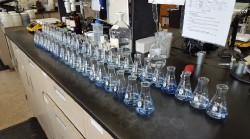
The WTRRF permit currently requires daily analysis of total phosphorus with a monthly average limit of .8 mg/L. Total phosphorus is the total concentration of phosphorus found in the wastewater. With upcoming water quality improvement initiatives and Total Maximum Daily Load (TMDL) studies, the Fond du Lac WTRRF will be required to reduce its total phosphorus by an additional 76% to 0.19 mg/L. Currently, compliance options for phosphorus removal technologies are being evaluated.
The laboratory has conducted extensive research on various species of phosphorus and how that may impact phosphorus uptake by aquatic systems and algae. Phosphorus is a nutrient and acts as a fertilizer, increasing the growth of plant life. Phosphorus comes from several sources: human wasters, animal wastes, industrial wastes, and human disturbance of the land and its vegetation. Sewage from wastewater treatment plants and septic tanks is also a source of phosphorus in rivers.
Total Suspended Solids is a water quality measurement usually abbreviated as TSS. It is listed as a conventional pollutant in the U.S. Clean Water Act. It is a measure of the amount of small, particulate solid pollutants that are suspended in wastewater after treatment. These particles suspended in water will not pass through a filter. Suspended solids are present in sanitary wastewater and many types of industrial wastewater. TSS can include a wide variety of organic and inorganic materials, such as silt, decaying plant and animal matter, industrial wastes, and sewage.
